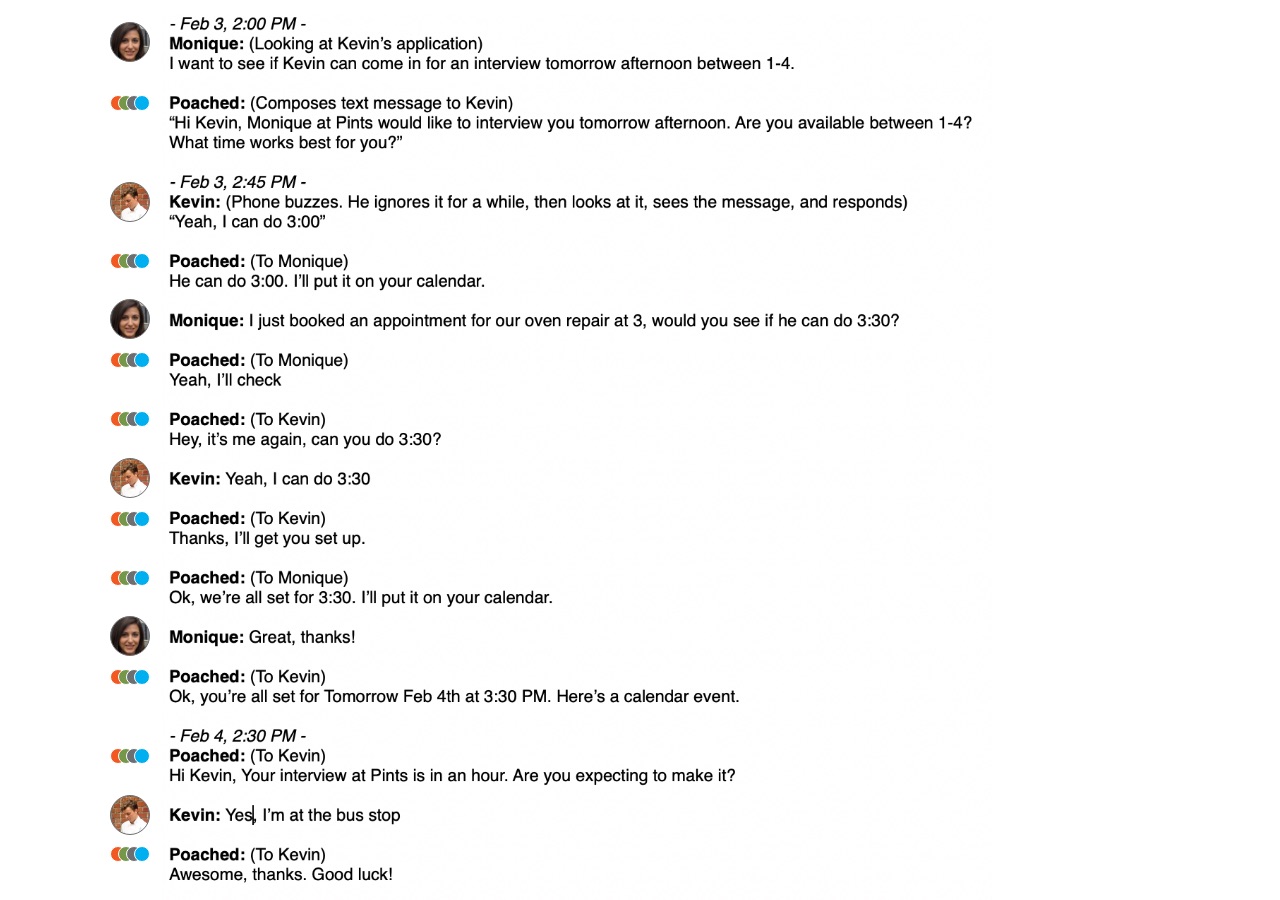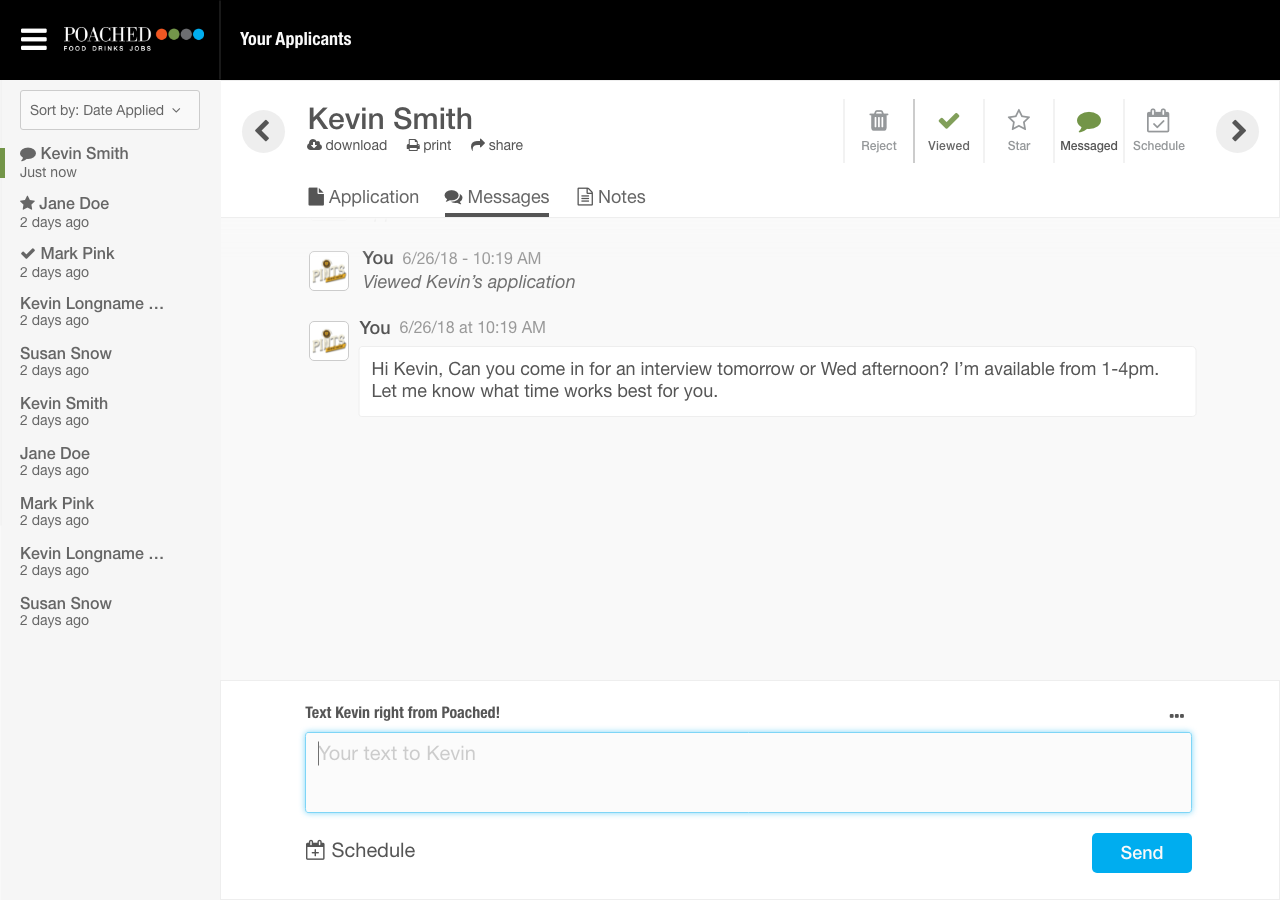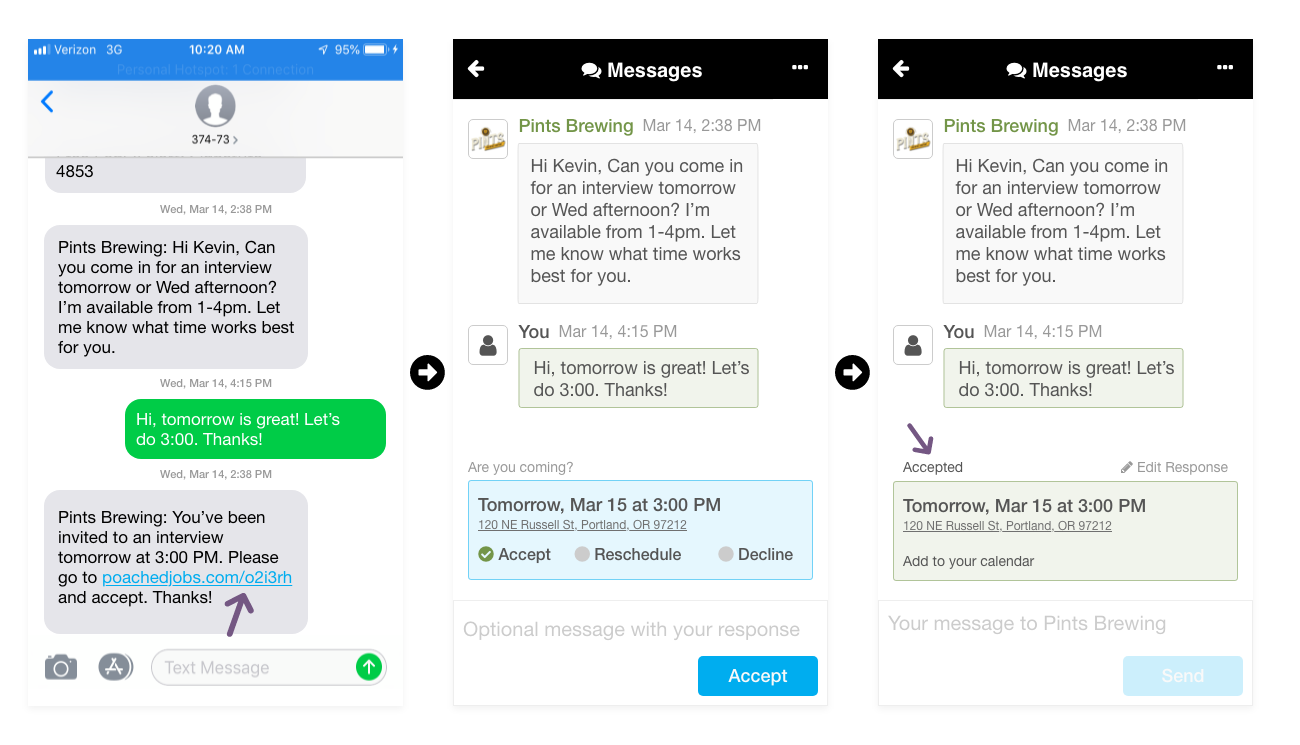← Back
Changing Behavior with Cross-Channel Design
My Role
Principal Product Designer (2016 - 2020)
Worked with PM, Engineering & Growth teams, and the Founder at Poached Jobs
Skills Used
Product Strategy & Vision, Qualitative & Quantitative Research, Interaction Design, Mobile Design, Visual Design, Prototyping, SMS, Cross-Channel UX, Data, KPIs
Summary
Restaurants have trouble getting applicants to show up for interviews. I designed an SMS based scheduling and reminder system that makes life better for both restaurants and job seekers. The outcome was a 4x decrease in response times and 13x more interviews scheduled.
Discovery
A few facts emerged from our ongoing qualitative and quantitative research that helped us prioritize this project:
- 70% of job seekers use Poached on their phones and prefer texting to email.
- Interview response rates were low and response times were high.
- Scheduling often required back-and-forth to set a time.
- Candidates often do not show up when scheduled for an interview (common industry problem).
Focus on the Customer
Reviewing our personas and talking to both customers and job seekers helps paint a clearer picture of the problem.
- Job seekers want to show up for interviews, they just don't have their shit together and need some help.
- Among our customer personas, the restaurant owner faces the biggest hiring challenges. We can have the biggest impact on this persona.

Understand the Problem Space
If Monique isn't using Poached to contact applicants and schedule interviews, what's she using?
- Using a built-in calendar like Google or a scheduling app like Calendly — These both still require an email, where the candidate isn't responsive.
- Texting the number on the candidate's resume from her mobile phone — She doesn't want to do this, and it would turn into a disorganized mess.
Make Hypotheses
Based on what we know so far we believe that:
- Monique doesn’t have the luxury of scheduling much in advance.
- Kevin will be more responsive by text message.
- Facilitating a conversation between them will improve scheduling.
- Automating reminders within that conversation will reduce no-shows. (Change behavior)
Planning
Set Objectives
Every good design project starts with objectives and an idea about how to gauge results.
- Increase usage (more interviews scheduled)
- Higher response rates, faster response times
- Decrease no-shows* (we have no baseline so we'll need to establish one first)
Think Conversational
An interaction with a product is a conversation with that product. I scripted the experience for both users as they engage with Poached and each other, and mapped out the cross-platform (web app, email, sms) user flows.
Conversational design concept
Evaluate the Approach
This is where it's a good idea to talk to customers again. Before building anything we can verify whether we're on the right track. In this case, customers and stakeholders all felt like we were on the right track.
Design
With clear objectives, and an existing design system I could go straight into high fidelity designs.
Monique reaches out to Kevin about an interview
Keep Asking Questions
Every step of the design process requires curiosity and questioning assumptions.
- When do we send the candidate a reminder?
- How far in advance are interviews scheduled? Are they scheduled on the same day?
- What events should we notify each party about?
- How do we keep the text messages concise? Adapt them to email?
- What if the candidate wants to stop getting texts or the employer wants to end a conversation?

Have Data? Use Data
I dug into our existing data to inform our decisions. For example, I found that 50% of interviews were scheduled 1-2 days out, and almost 20% were scheduled on the day of the interview. These kinds of insights are valuable. Now I knew that scheduling interviews day-of wasn’t a hypothetical edge case.
Monique schedules an interview
Track Your Decisions
Design is a series of decisions. To record our decisions and manage all the complexity I put everything into spreadsheets.
- I created a list of messages by platform (e.g. reminder via SMS) and wrote copy for every variation including an example and a template for each.
- I compiled a list of events, and whether each event triggered a status change in the app or notification to the user. I defined the status labels and any CTA for the user and wrote copy for each notification.
- I defined rules for sending reminders based on variables like the time of day and the time between the invite and the actual interview.

Sweat the Details
I designed the messaging interface to be familiar and helpful. I initially used color to highlight the messages the user cares about - incoming messages. However, the iOS text app does the opposite. When Kevin receives a text message and then follows a link into Poached, the experience needs to be seamless. This meant adjusting my design to be more consistent with iOS.
First design on the left, updated design on the right
Key Results
Thanks to the work I did to keep track of the details and document our decisions, the development process went smoothly and the project was successful. Within a few months of the release here's how things measured up against our objectives:

What's Next?
Like with any project, plenty of nice-to-have ideas and features were cut, so that we could ship something to customers sooner. We captured these in the backlog so that we would be able to prioritize them if and when the time is right.

Design Walk-Through
← Back














